Most cacti can survive up to two years without water, making them nature’s ultimate low-maintenance houseplants. You’ll find these desert dwellers particularly appealing if you’re busy, forgetful, or simply practical about your indoor gardening habits. While you’ve likely encountered common varieties at garden centers, several lesser-known species offer stunning shapes and unexpected blooms with minimal care requirements. The following collection of self-sufficient cacti might just change your perspective on desert plants.
Contents
- 1 1. Prickly Pear Cactus
- 2 2. Barrel Cactus
- 3 3. Christmas Cactus
- 4 4. San Pedro Cactus
- 5 5. Mexican Fence Post Cactus
- 6 6. Dragon Fruit Cactus
- 7 7. Golden Ball Cactus
- 8 8. Saguaro Desert Giant Cactus
- 9 9. Indian Corn Cactus
- 10 10. Queen of the Night
- 11 11. Moon Night-Blooming Cactus
- 12 12. Totem Pole Desert Cactus
- 13 13. Blue Columnar Torch Cactus
- 14 14. Peruvian Apple Cactus
- 15 15. Bunny Ears Desert Cactus
1. Prickly Pear Cactus

The Prickly Pear Cactus (Opuntia) is a versatile and hardy succulent characterized by its flat, paddle-shaped segments called pads or cladodes. Native to the Americas, this cactus can grow anywhere from 1 to 7 feet tall and produces vibrant yellow, pink, or red flowers in spring, followed by edible fruits. The pads are covered in clusters of sharp spines and tiny, barbed bristles called glochids, which can easily detach and irritate skin. Despite its intimidating appearance, the Prickly Pear is popular in home gardens for its drought tolerance and unique aesthetic appeal.
- Light: Full sun; minimum 6 hours of direct sunlight daily
- Water: Minimal; water deeply but infrequently, allowing soil to dry completely between waterings
- Soil: Well-draining, sandy or rocky soil; can tolerate poor soil conditions
- Temperature: Hardy in zones 4-11; prefers hot, dry conditions
- Humidity: Low humidity; tolerates dry air well
- Fertilizer: Light feeding with cactus fertilizer during growing season
- Drainage: Excellent drainage required; cannot tolerate wet feet
- Space: 2-4 feet between plants for adequate growth
- Container: Clay or terracotta pots with drainage holes
- pH: 6.0-7.5
2. Barrel Cactus
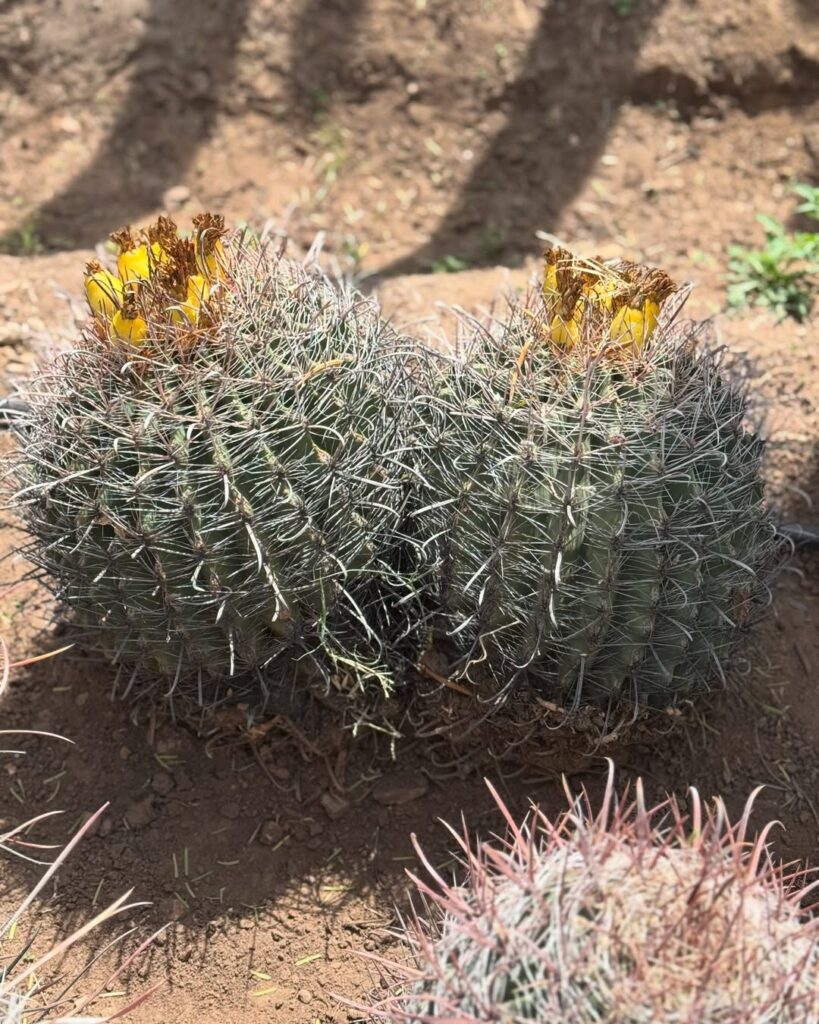
The Barrel Cactus is a spherical to cylindrical-shaped desert plant known for its distinctive ribbed appearance and prominent spines arranged in clusters along its body. These hardy succulents can grow quite large, reaching heights of up to 6 feet in some species, though they typically grow slowly. Their yellow or red flowers bloom at the top of the plant during spring and summer, forming a crown-like arrangement, and they’re particularly valued for their structural appeal in desert landscaping and indoor collections.
- Light: Full sun to partial shade; requires at least 6 hours of direct sunlight daily
- Water: Minimal watering needed; allow soil to dry completely between waterings; reduce watering in winter
- Soil: Well-draining cactus mix or sandy soil with added perlite and gravel
- Temperature: Prefers warm conditions between 70-80°F (21-27°C)
- Humidity: Low humidity levels; tolerates dry air well
- Fertilizer: Light feeding with cactus fertilizer during growing season
- Container: Wide, shallow pot with drainage holes to accommodate spreading root system
- pH: Slightly acidic to neutral (6.0-7.0)
3. Christmas Cactus
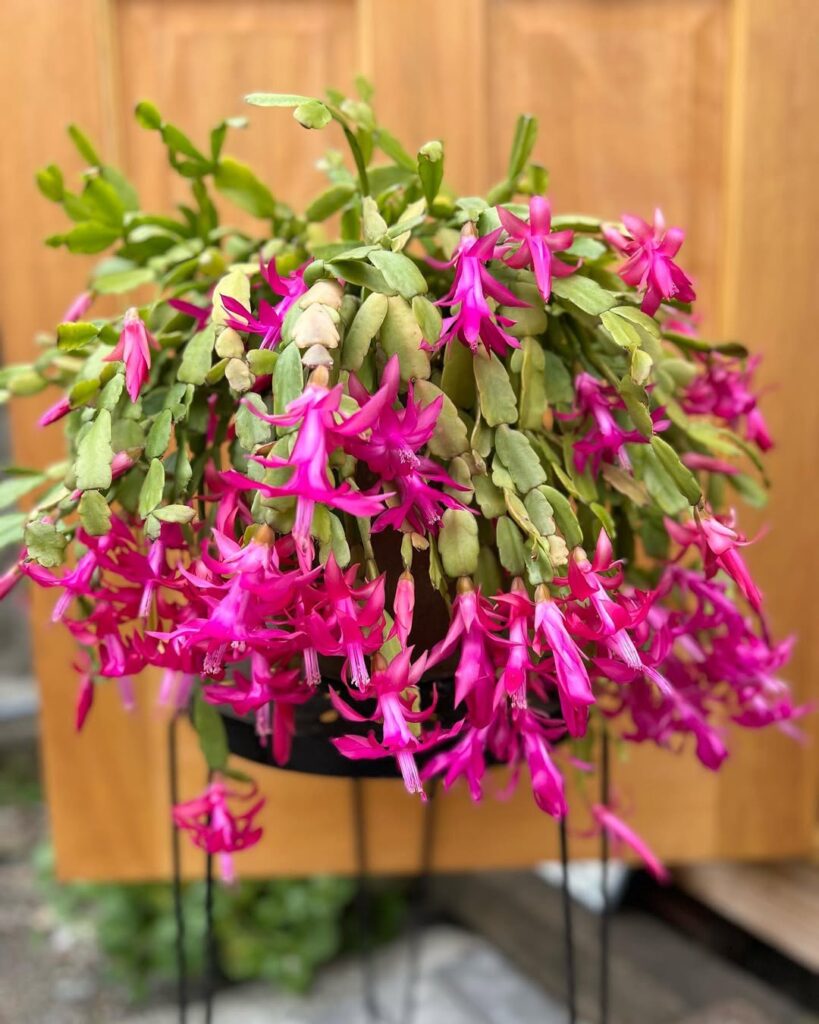
The Christmas Cactus (Schlumbergera bridgesii) is a popular holiday houseplant known for its vibrant pink, red, or white blooms that typically appear around December. Unlike desert cacti, this epiphytic species is native to Brazilian rainforests, growing naturally on trees or rocks. It features flat, segmented stems that cascade downward, making it ideal for hanging baskets or as a tabletop plant. With proper care, this long-lived succulent can be passed down through generations and reliably bloom year after year.
- Light: Bright, indirect light; avoid direct sunlight; can tolerate lower light conditions
- Water: Keep soil moderately moist during growing season; reduce watering in fall to promote blooming
- Soil: Well-draining potting mix with organic matter; preferably a mix designed for cacti and succulents
- Humidity: Prefers higher humidity levels (50-60%)
- Temperature: 65-75°F (18-24°C); needs cooler temps (55-65°F) to trigger blooming
- Fertilizer: Feed monthly with balanced fertilizer during growing season; stop during blooming period
- Container: Use pot with drainage holes; prefers to be slightly root-bound
- pH: 5.5-6.2 (slightly acidic)
4. San Pedro Cactus
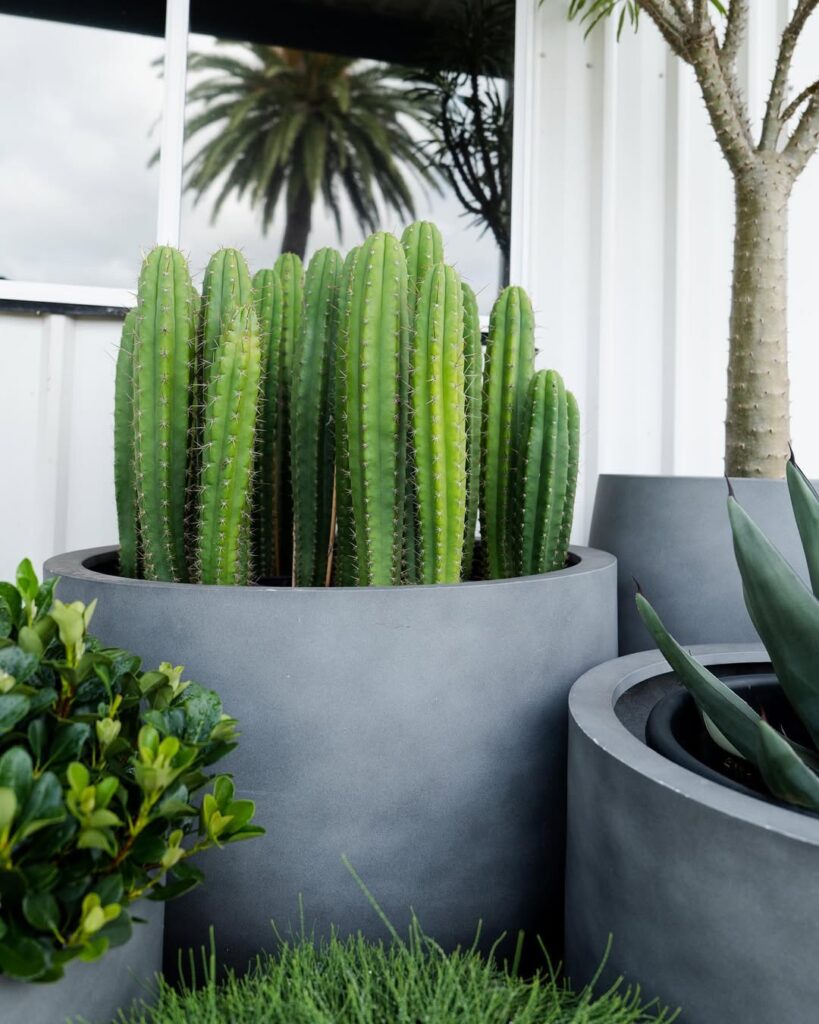
The San Pedro cactus (Echinopsis pachanoi) is a fast-growing columnar cactus native to the Andes Mountains that can reach heights of up to 20 feet tall. Known for its blue-green color and typically 6-8 ribbed stems, this cactus produces large, white, night-blooming flowers during summer months. It’s a popular choice among gardeners for its relatively quick growth rate and architectural presence in both indoor and outdoor settings.
- Light: Full sun to partial shade; at least 6 hours of direct sunlight daily
- Water: Moderate watering during growing season; allow soil to dry completely between waterings; reduce watering considerably in winter
- Soil: Well-draining cactus mix or regular potting soil mixed with sand and perlite
- Temperature: Prefers warm conditions between 70-80°F (21-27°C); can tolerate brief periods down to 50°F (10°C)
- Humidity: Tolerates average household humidity; prefers dry conditions
- Fertilizer: Feed with diluted cactus fertilizer every 4-6 weeks during growing season
- Container: Deep pot with drainage holes to accommodate extensive root system
5. Mexican Fence Post Cactus
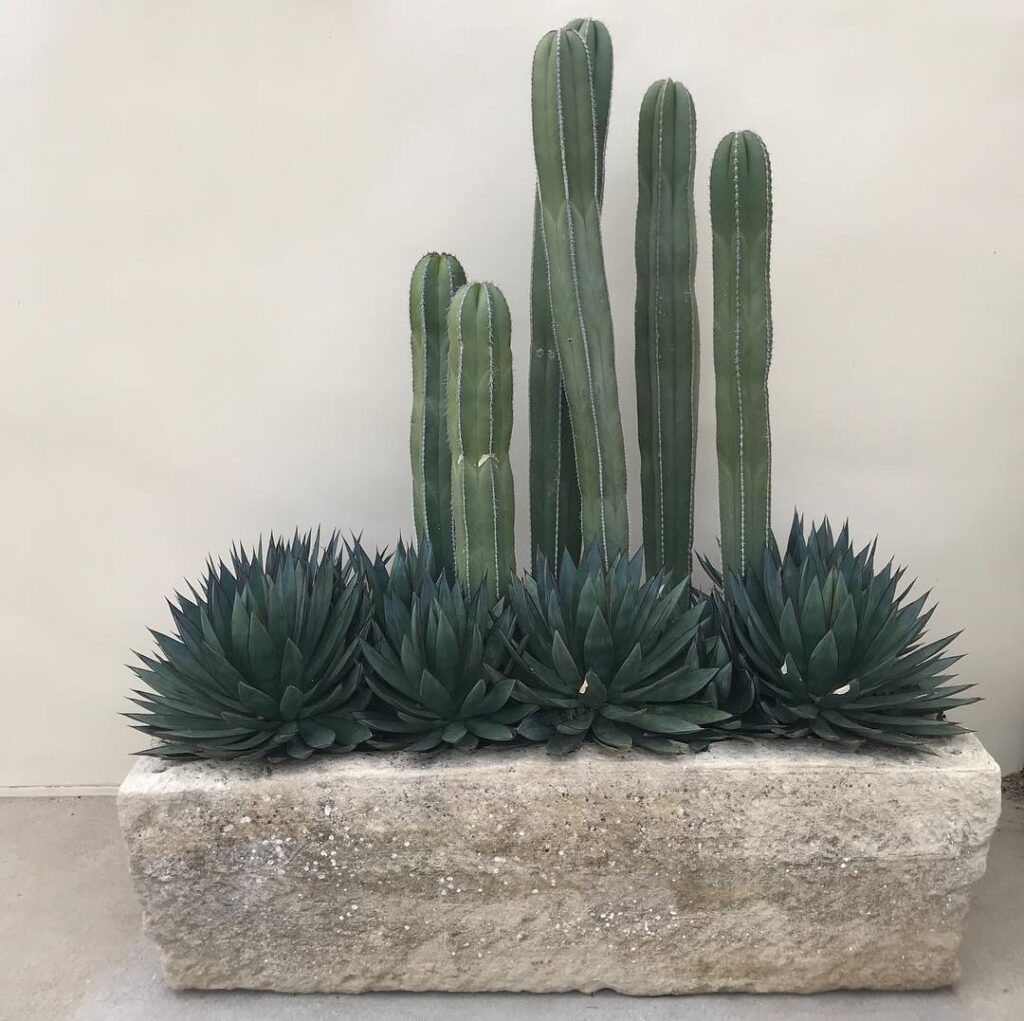
The Mexican Fence Post Cactus (Pachycereus marginatus) is a tall, columnar cactus native to central Mexico that can grow up to 20 feet high. Its distinctive appearance features straight, bluish-green ribs with prominent white or gray areoles running vertically along its sides, creating a fence post-like appearance. This architectural plant produces pink to cream-colored flowers in spring, followed by red fruits, though blooming is rare in cultivation. Its upright growth pattern and hardy nature make it an excellent choice for desert landscaping or as a natural living fence.
- Light: Full sun to partial shade; requires at least 6 hours of direct sunlight daily
- Water: Minimal; water thoroughly when soil is completely dry
- Soil: Well-draining cactus mix or sandy soil
- Temperature: Hardy in USDA zones 9-11; protect from frost
- Humidity: Low humidity preferred
- Fertilizer: Light feeding with cactus fertilizer during growing season
- Space: Plant 2-3 feet apart if creating a fence line
- Container: Deep container with drainage holes if grown as potted plant
- Winter Care: Reduce watering considerably; protect from temperatures below 25°F
6. Dragon Fruit Cactus
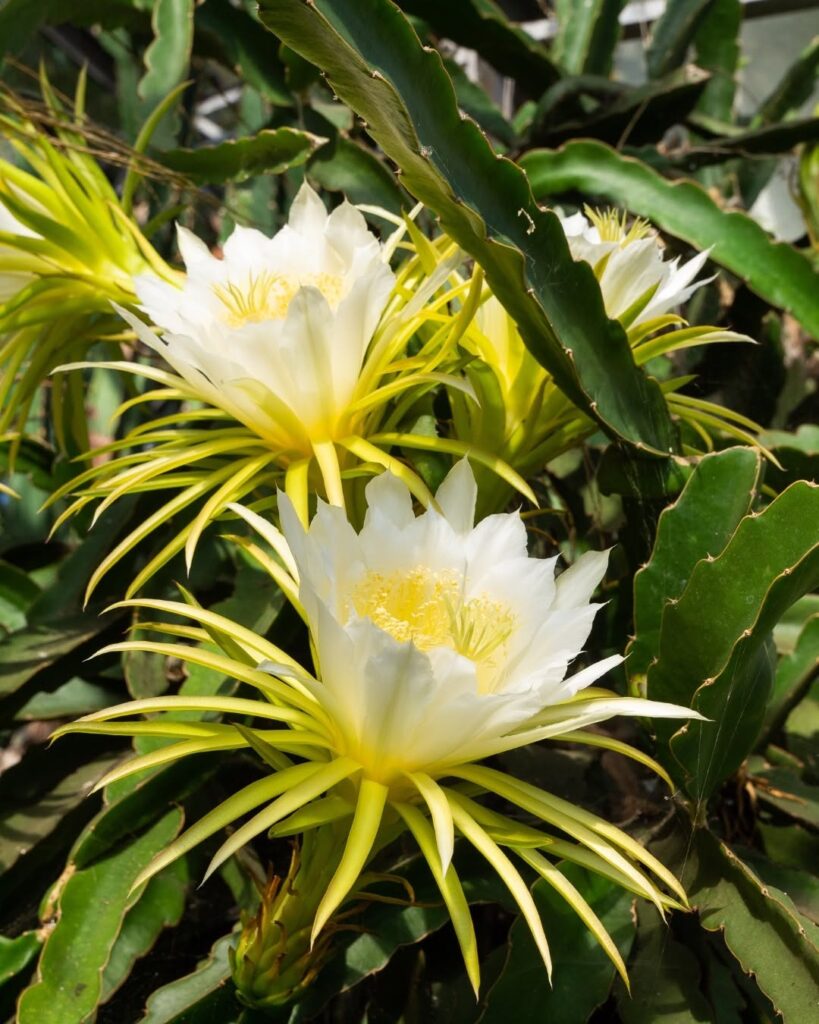
The Dragon Fruit Cactus (Hylocereus undatus) is a climbing succulent known for producing striking pink or red oval fruits with white or pink flesh studded with black seeds. Native to Central and South America, this fast-growing cactus develops long, triangular stems with aerial roots that help it climb and attach to surfaces. The plant produces large, fragrant white flowers that bloom at night, typically for just one evening, earning it the nickname “Queen of the Night.” While grown primarily for its edible fruit, it’s also an attractive ornamental plant that can reach lengths of 20 feet or more when properly supported.
- Light: Bright, indirect sunlight; can tolerate full sun in cooler climates but needs partial shade in hot regions
- Water: Moderate watering when soil is dry to touch; reduce in winter; avoid overwatering
- Soil: Well-draining cactus mix or regular potting soil amended with sand and perlite
- Temperature: 65-85°F (18-29°C); protect from frost
- Humidity: Tolerates average household humidity
- Support: Requires a trellis, pole, or other climbing structure
- Fertilizer: Monthly feeding during growing season with balanced fertilizer
- Container: Large pot with multiple drainage holes to accommodate extensive root system
7. Golden Ball Cactus
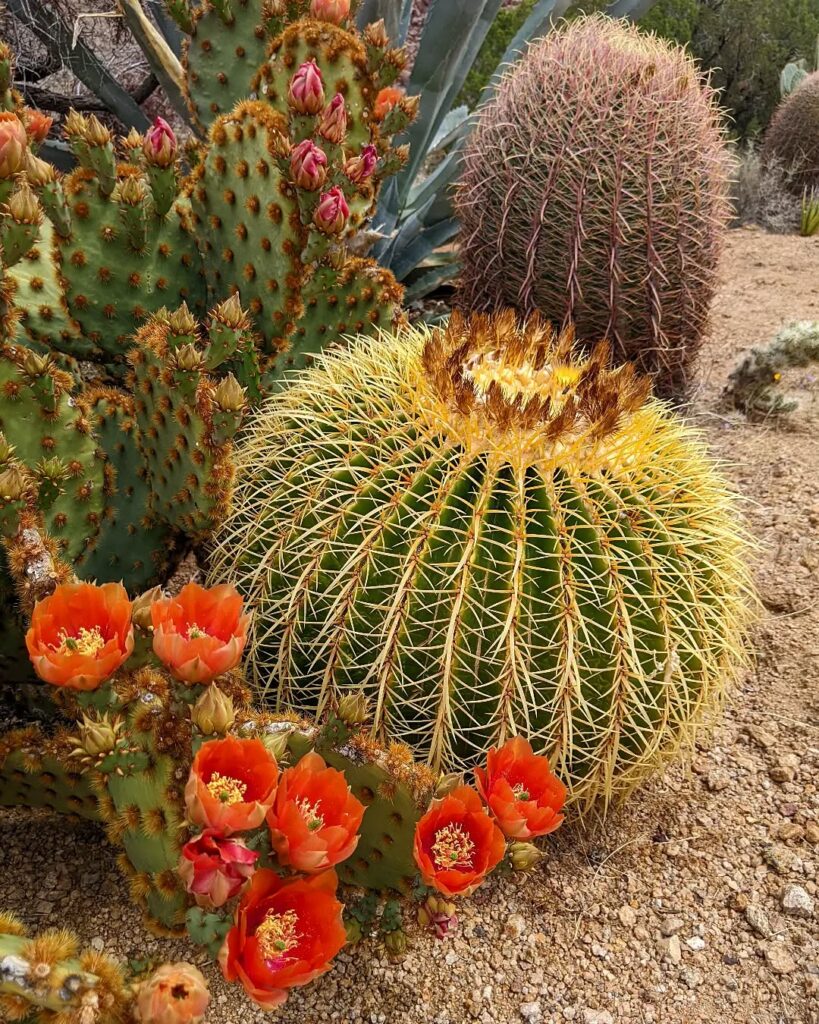
The Golden Ball Cactus (Echinocactus grusonii) is a spherical cactus known for its distinctive golden spines and barrel shape. Native to central Mexico, this slow-growing specimen can reach up to 4 feet in diameter when mature, though it typically remains smaller in cultivation. Its ribbed body features prominent areoles with sharp yellow spines arranged in a striking geometric pattern, making it a popular choice for both indoor and outdoor desert gardens. The cactus occasionally produces yellow flowers at its crown when mature, though blooming is rare in cultivation.
- Light: Full sun to partial shade; minimum 6 hours of direct sunlight daily
- Water: Minimal; water thoroughly only when soil is completely dry, reduce watering in winter
- Soil: Well-draining cactus mix with added inorganic materials like pumice or perlite
- Temperature: Tolerates 20-100°F (-6-38°C); protect from frost
- Humidity: Low humidity preferred; tolerates average household humidity
- Fertilizer: Light feeding with balanced cactus fertilizer during growing season
- Container: Wide, shallow pot with drainage holes
- Growing Zone: USDA zones 9-11 for outdoor growth
8. Saguaro Desert Giant Cactus
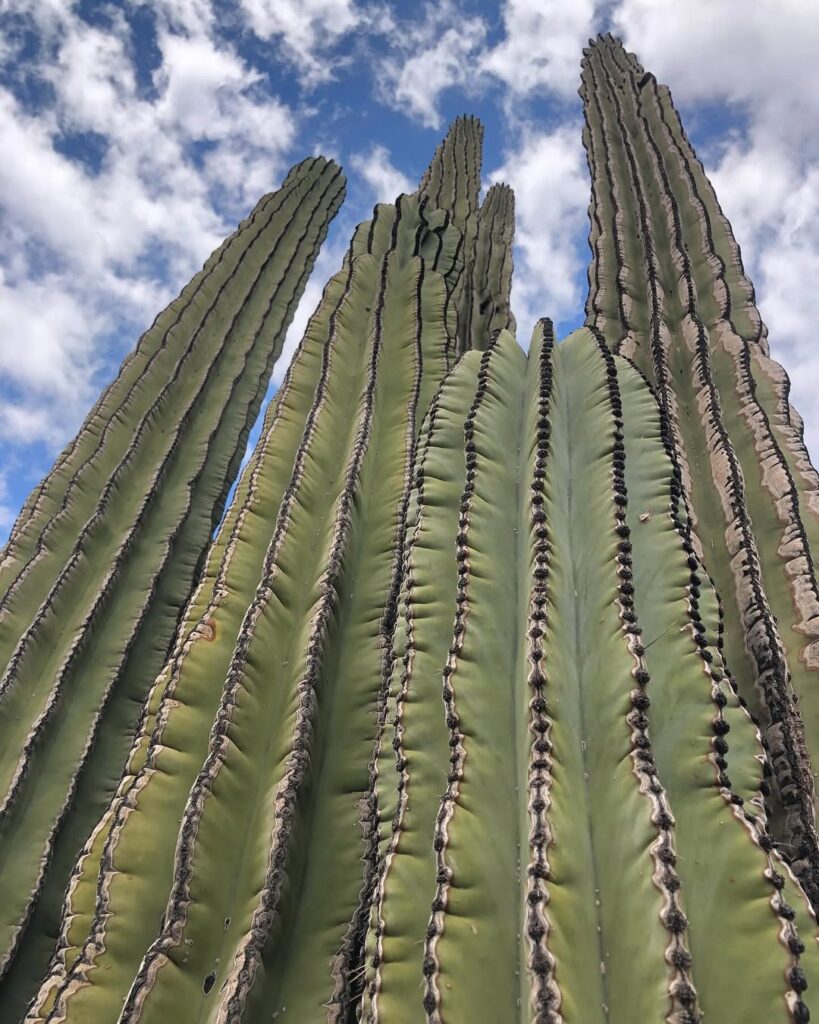
The Saguaro (Carnegiea gigantea) is an iconic symbol of the American Southwest, known for its massive height of up to 40-60 feet and distinctive arm-like branches that develop after 75+ years of growth. This slow-growing desert giant can live for 150-200 years and produces large white flowers in spring, followed by red fruit. The cactus starts life under “nurse plants” that provide shade and protection, and it develops its first arm only after reaching 50-70 years of age.
- Light: Full, direct sunlight; minimum 6 hours daily
- Water: Very minimal; monthly deep watering in summer, almost none in winter
- Soil: Well-draining, sandy or rocky soil with low organic content
- Temperature: Thrives in hot conditions; cannot tolerate freezing temperatures below 30°F
- Humidity: Low humidity preferred; excellent air circulation required
- Growing Zone: USDA zones 9-11
- Container: Not typically grown in containers due to size; only suitable for outdoor desert landscapes
- Fertilizer: None required; desert soil conditions preferred
9. Indian Corn Cactus

The Indian Corn Cactus (Bergerocactus emoryi) is a cylindrical, clustering cactus that grows in dense clumps with numerous upright stems reaching up to 6 feet tall. Each stem is covered in dense, golden-yellow spines that give the plant a distinctive corn-like appearance. Native to coastal areas of southern California and northern Mexico, this cactus produces bright yellow flowers in spring, followed by small, round, reddish fruits.
- Light: Full sun to partial shade; best growth occurs with at least 6 hours of direct sunlight daily
- Water: Minimal watering needed; water thoroughly but allow soil to dry completely between waterings
- Soil: Well-draining cactus mix or sandy soil with added perlite and gravel
- Temperature: Hardy in zones 9-11; tolerates temperatures down to 25°F (-4°C)
- Humidity: Low humidity preferred; tolerates coastal conditions
- Fertilizer: Light feeding with balanced cactus fertilizer during growing season
- Container: Clay or terracotta pots with drainage holes
10. Queen of the Night

The Queen of the Night (Epiphyllum oxypetalum) is a striking night-blooming cactus known for its large, fragrant white flowers that bloom for just one night before wilting by dawn. This exotic epiphytic cactus features long, flat, leaf-like stems and can grow up to 10 feet tall when properly supported. While the blooming event is rare and brief, the spectacular 8-12 inch flowers make it a coveted specimen among plant enthusiasts.
- Light: Bright, indirect light; avoid direct sunlight which can burn leaves
- Water: Allow soil to dry between waterings; reduce watering in winter
- Soil: Well-draining potting mix with organic matter; orchid mix works well
- Humidity: Moderate to high humidity (50-70%)
- Temperature: 60-80°F (15-27°C)
- Container: Use hanging baskets or pots with good drainage
- Support: Provide trellis or support structure for climbing
- Fertilizer: Feed monthly during growing season with balanced fertilizer
11. Moon Night-Blooming Cactus
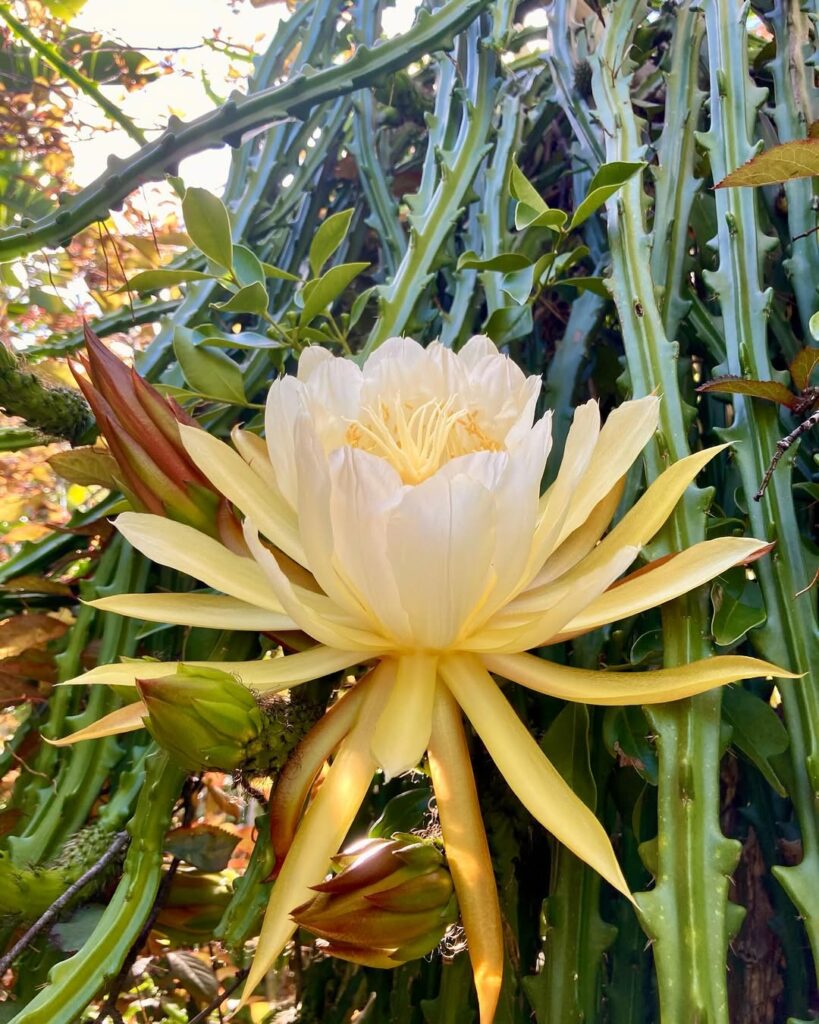
The Moon Night-Blooming Cactus (Selenicereus grandiflorus) is a climbing cactus species known for its spectacular white flowers that bloom only at night and wilt by dawn. Native to the Caribbean and parts of Central America, this epiphytic cactus produces large, fragrant blooms measuring up to 8 inches in diameter, making it a prized specimen for nocturnal gardens. Its thin, rope-like stems can grow extensively, featuring small spines and aerial roots that help it climb and attach to surfaces.
- Light: Bright, indirect sunlight; can tolerate partial shade; protect from intense afternoon sun
- Water: Allow soil to dry between waterings; reduce watering in winter; mist occasionally to increase humidity
- Soil: Well-draining cactus mix with added organic matter
- Temperature: 60-80°F (15-27°C); not frost tolerant
- Humidity: Moderate humidity levels (40-50%)
- Container: Use hanging baskets or provide climbing support
- Fertilizer: Feed with balanced cactus fertilizer during growing season (spring to fall)
- Growing Space: Provide adequate space for climbing; stems can reach 20+ feet
12. Totem Pole Desert Cactus
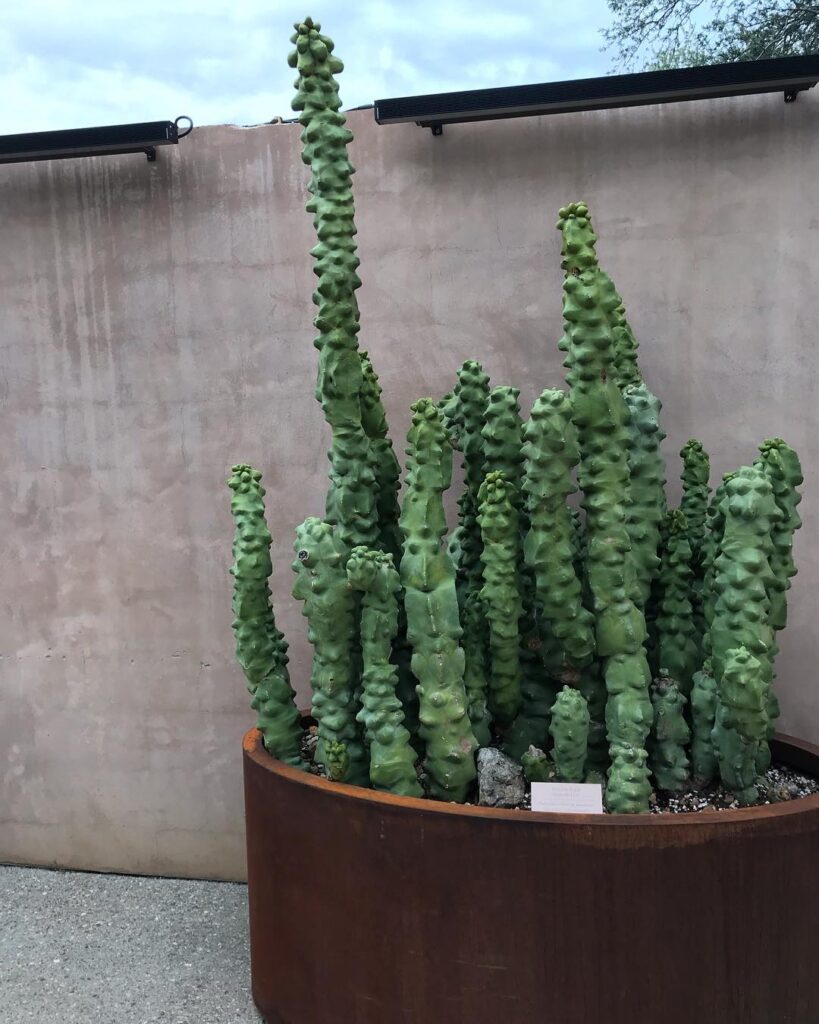
The Totem Pole Desert Cactus (Lophocereus schottii) is a spineless columnar cactus known for its smooth, blue-green stems that grow in irregular, bumpy patterns resembling a carved totem pole. This slow-growing succulent can reach heights of 10-12 feet in its natural habitat, though it typically stays smaller when grown as a houseplant. Its distinctive appearance and minimal maintenance requirements make it a popular choice for both indoor and outdoor desert gardens.
- Light: Full sun to partial shade; requires at least 6 hours of direct sunlight daily
- Water: Minimal watering needed; allow soil to dry completely between waterings; reduce watering in winter
- Soil: Well-draining cactus mix or regular potting soil mixed with sand and perlite
- Temperature: Thrives in warm conditions between 70-100°F (21-38°C); protect from frost
- Humidity: Tolerates low humidity levels
- Fertilizer: Light feeding with balanced cactus fertilizer during growing season
- Container: Terracotta or clay pots with drainage holes
- Growth Zone: USDA zones 9-11
13. Blue Columnar Torch Cactus
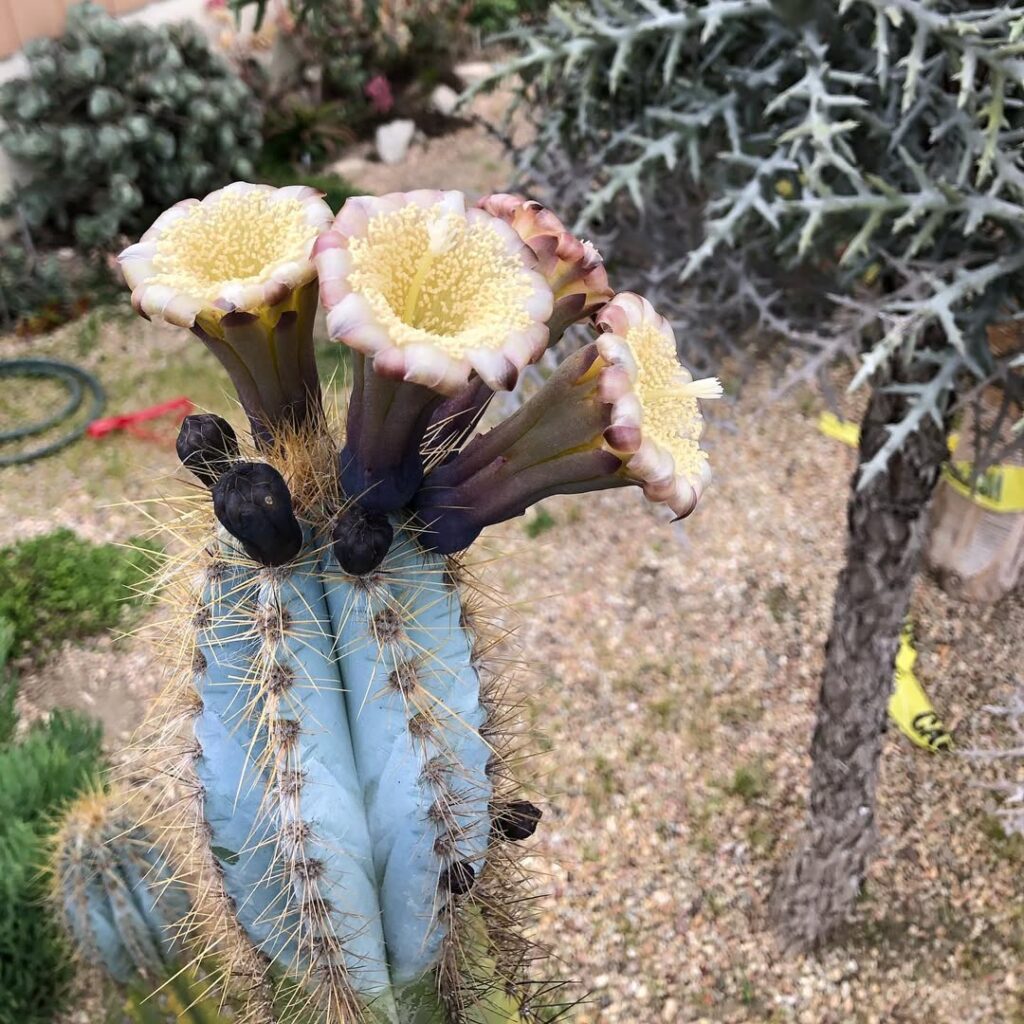
The Blue Columnar Torch Cactus (Pilocereus azureus) is a striking columnar cactus known for its bluish-gray stems and prominent white spines. Growing up to 20 feet tall in its natural habitat, this slow-growing Brazilian native develops multiple ribbed columns that create a dramatic architectural statement. When mature, it produces large white flowers that bloom at night during summer months, followed by small purple fruits.
- Light: Full sun to partial shade; needs at least 6 hours of direct sunlight daily
- Water: Moderate watering during growing season; reduce considerably in winter
- Soil: Well-draining cactus mix with added inorganic materials like pumice or perlite
- Temperature: Thrives in warm conditions; not frost hardy below 30°F
- Humidity: Tolerates low humidity levels
- Fertilizer: Light feeding with balanced cactus fertilizer during growing season
- Container: Deep pot with drainage holes to accommodate vertical growth
14. Peruvian Apple Cactus
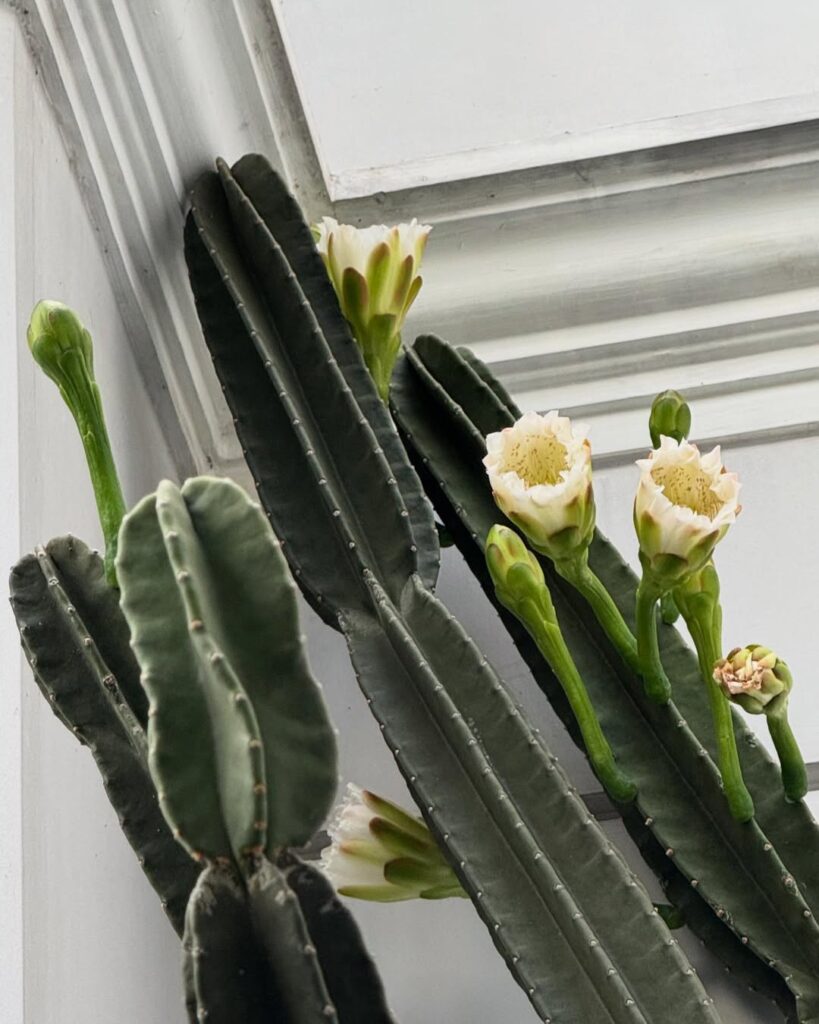
The Peruvian Apple Cactus (Cereus peruvianus) is a tall, columnar cactus that can reach heights of up to 30 feet in its natural habitat. Known for its bluish-green stems and large, white, nocturnal flowers that bloom during summer months, this cactus also produces edible red fruits that resemble small apples. Its ribbed structure features areoles with short spines, and it grows relatively quickly compared to other cacti species, making it a popular choice for both indoor and outdoor cultivation.
- Light: Full sun to partial shade; requires at least 6 hours of direct sunlight daily
- Water: Moderate watering during growing season; reduce considerably in winter; allow soil to dry completely between waterings
- Soil: Well-draining cactus mix or regular potting soil amended with sand and perlite
- Temperature: Thrives in warm conditions between 70-80°F (21-27°C); can tolerate brief periods down to 25°F (-4°C)
- Humidity: Tolerates average household humidity; prefers dry conditions
- Container: Deep pot with drainage holes to accommodate extensive root system
- Fertilizer: Light feeding with balanced cactus fertilizer during growing season
15. Bunny Ears Desert Cactus
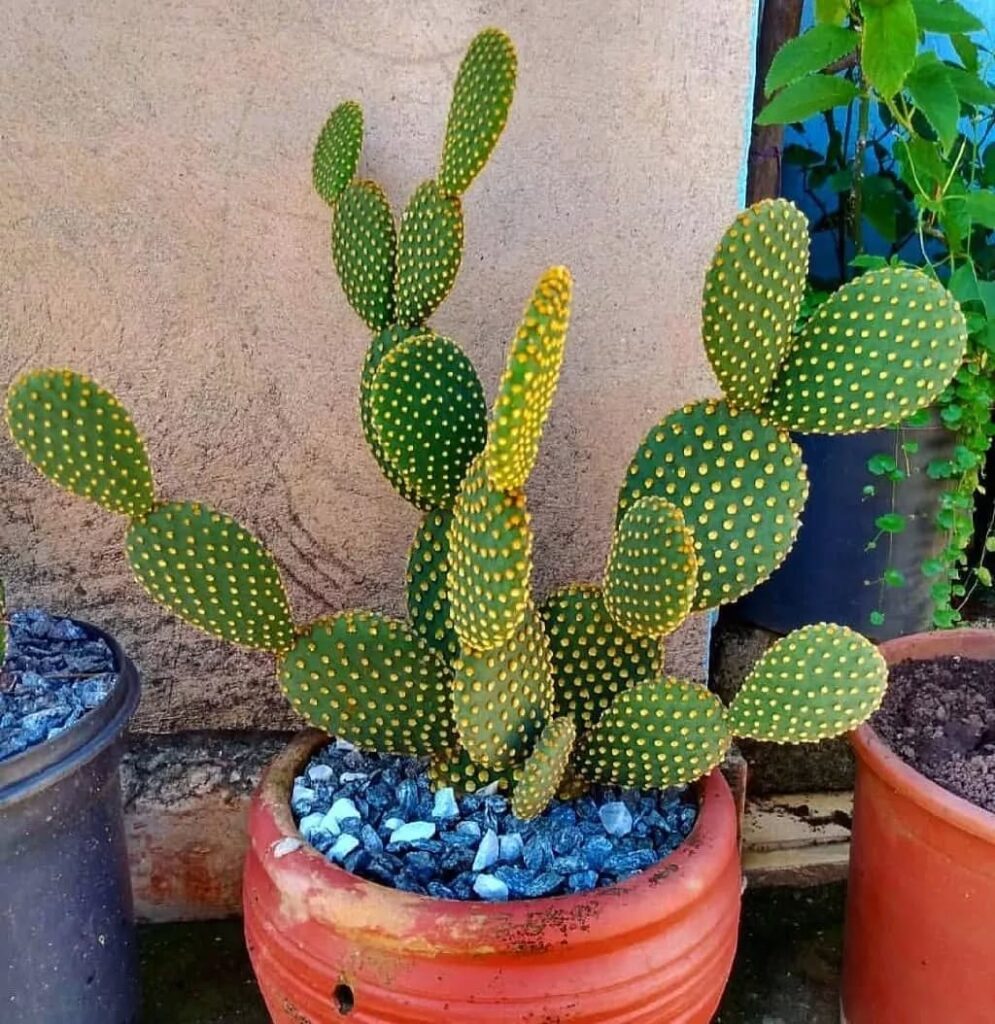
The Bunny Ears Cactus (Opuntia microdasys) is a charming, compact desert plant known for its distinctive pad formations that resemble rabbit ears. Originally from Mexico, this spineless cactus features numerous small, golden-yellow clusters of glochids covering its flat, round pads. Growing to about 2-3 feet tall and wide, it produces bright yellow flowers in spring, though blooming is rare in indoor specimens. Despite its cute appearance, care should be taken when handling as the glochids can easily detach and irritate skin.
- Light: Full sun to partial shade; minimum 6 hours of direct sunlight daily
- Water: Minimal; water thoroughly when soil is completely dry
- Soil: Well-draining cactus mix or regular potting soil mixed with sand and perlite
- Temperature: 70-100°F (21-38°C); can tolerate brief periods down to 20°F (-6°C)
- Humidity: Low; tolerates dry indoor conditions well
- Fertilizer: Light feeding with cactus fertilizer during growing season
- Container: Clay or terracotta pot with drainage holes
- pH: 6.0-7.5
